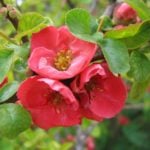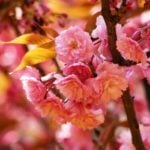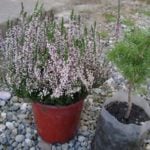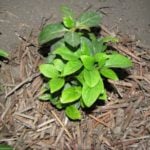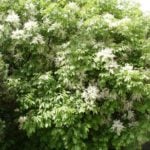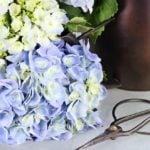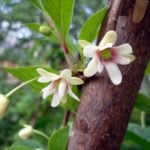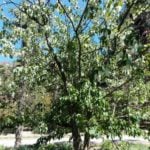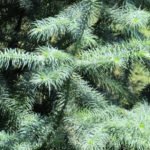Hydrangea paniculata can be safely attributed to one of the best ornamental shrubs for suburban and garden areas of the middle zone. It is distinguished not only by abundant and prolonged flowering, but also by high winter hardiness, which is very important for regions with a cold climate. For example, tall (up to 2-2. 5 m tall) variety ‘Dentelle de Gorron’, decorated at the time of flowering large (30-35 cm long) inflorescences-panicles, changing color from white-green to pale cream, can withstand frosts up to -34 degrees.
And of course, Hydrangea paniculata take pride of place in cold regions, because these beauties are a real decoration for places with a harsh climate.
Hydrangea paniculata tolerate even very severe frosts and do not need shelter for the winter, but to take care of additional mulching of the soil under the Bush will not be superfluous — it will protect the root system not only from the cold, but also from drying out, especially in the low-snow winter.
Why should you plant hydrangea in your garden
This shrub is very plastic, easily fits into a variety of styles and filling garden compositions, and a wide variety of colors, sizes and shapes allows you to choose the best variety for any garden.
Pay attention, for example, to the popular variety ‘Phantom’, whose powerful straight shoots in August-September are decorated with large creamy-white inflorescences, gradually changing color to pale pink. Or maybe your attention will be attracted by ‘Dolly’ – flowering from July to September Bush up to 2 m, whose lush white inflorescences elegant cone-shaped perfectly stand in the cut and also turn pink in the autumn.

Hydrangea paniculata is well combined with conifers, ornamental shrubs (Berberis, Philadelphus, Physocarpus, Spiraea and others). They will make a harmonious composition with decorative deciduous perennials-Hosta, ferns, tall Sedum, Poaceae.
In the garden, Hydrangea paniculata can be used as a solitaire-choose for this variety with large, lush inflorescences of beautiful shape and expressive color, for example:

- ‘Diamant Rouge’ – a tall (up to 2 m) Bush, whose large (30-40 cm long) inflorescences show wonderful transformations: white when blooming, the flowers first turn pink, then turn red and, finally, in August-red-purple;
- ‘Magical Moonlight’ – abundant and long (from July to September) flowering, powerful and very attractive hydrangea with huge dense white-green inflorescences up to 28 cm.

Owners of small plots will certainly appreciate compact varieties that do not require much space and can decorate a mixborder or a small flower garden. Some of them are suitable even for container cultivation; however, given the demands of hydrangea to moisture, it is important to think well about the placement of such a plant and take care of its systematic watering, because in containers the soil dries up much faster. Lovers of miniatures can attract varieties such as:

- ‘Bobo’ – a neat Bush up to 0.7 m tall and 0.5 m wide can be grown in a container; its vertical shoots from July to September are abundantly decorated with white, gradually turning pink conical inflorescences;
- ‘Little lime’ – large white-green inflorescences of this compact (up to 0.8-1 m tall) plants also turn pink in autumn;
- ‘Confetti’ – a distinctive feature of this variety is a delicate, delicate aroma of inflorescences; green buds, opening, become white flowers, which gradually change color to pale pink; compact Bush blooms all summer and is suitable for container cultivation.

Hydrangea paniculata look good near garden ponds, at the front porch, in hedges and shrub compositions. However, when choosing a place for planting, care should be taken that the Bush is protected from the wind.
No less important is the illumination — it can affect the appearance of the plant, and affect the color of the flowers can and bright sun, and thick shadow. When choosing a variety, be sure to pay attention to its preferences: some hydrangeas grow well in open Sunny areas, others need partial shade.
So, for example, the popular variety ‘Limelight’, decorated from July to September with large greenish-yellow inflorescences, changing color to creamy yellow, will fully reveal its varietal features only when planted in light penumbra. If you want to see the characteristic greenish-yellow color of the inflorescences, protect the plant from direct sunlight.

In General, the amazing and attractive ability of hydrangeas during flowering to change the color of inflorescences makes compositions with their participation changeable, dynamic and therefore even more interesting. In addition, this plant is a real godsend for owners of complex areas: shady, with a high level of groundwater and high soil acidity. Few crops will agree to grow in such conditions, but hydrangeas will like them. And you may be interested in her varieties:
- ‘Selection’ – Bush height 1-1, 2 m with creamy white, gradually turning pink inflorescences;
- ‘Diamantino’ – abundant and long (from June to September) flowering shrub with very dense inflorescences;
- ‘Magical Sweet Summer’ – hydrangea with white-cream inflorescences, acquiring a pink color in late summer;
- ‘Angels Blush’ – tall (up to 2-2. 5 m tall) shrub with white inflorescences, which first become pink, and by autumn turn red.

Hydrangea paniculata cultivation and care
The basis of success — the right choice of place for planting and proper soil preparation. Hydrangea paniculata likes loose acidic soil with high nutrient content and good moisture. Sandy and alkaline soils are not suitable for the plant. With a lack of nutrition, the leaves become smaller, pale; hydrangea flowers poorly and develops slowly.

Young bushes are especially sensitive to the lack of moisture, in dry weather they need to be watered regularly. Mulching will help to save moisture in the soil (you can use tree bark, coniferous litter, peat and other similar materials). A dense layer of mulch, in addition, inhibits the growth of weeds, which is also important for young shrubs.

The level of acidity of the soil can affect the decorative characteristics of the plant: it is noted that on acidic soil the color of the flowers is brighter. So, if your hydrangea looks paler than expected, maybe it’s not about over-grazing. Acidify the soil to see the inflorescences in all their glory.
For abundant and lush hydrangea flowering, a formative pruning is necessary. However, it is important to understand that the nature of pruning depends on the characteristics of the variety: one needs a fairly intense “haircut”, the other — gentle, moderate. Pruning is carried out in the spring, and in the winter the shrub can be tied with twine, so that the branches do not break under the snow.


